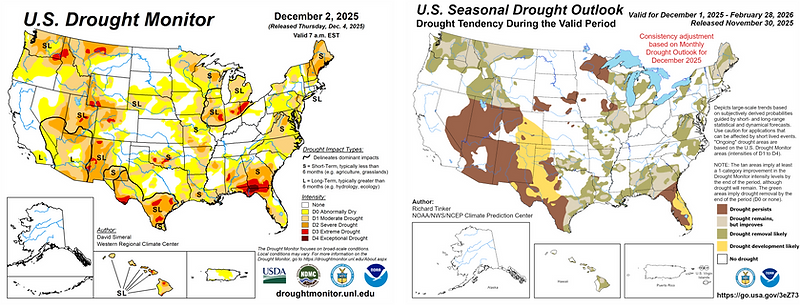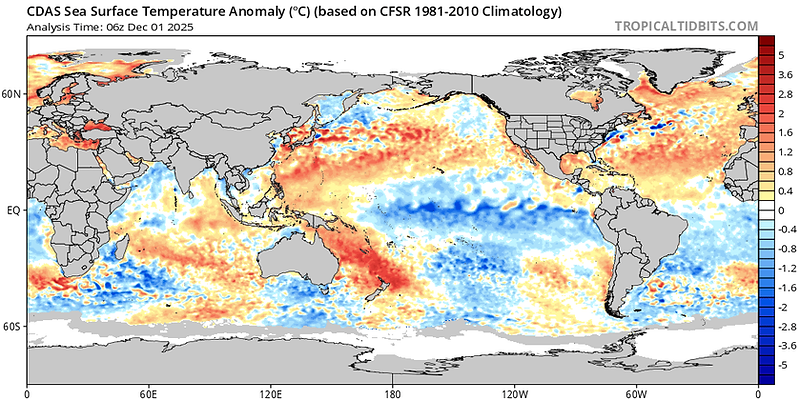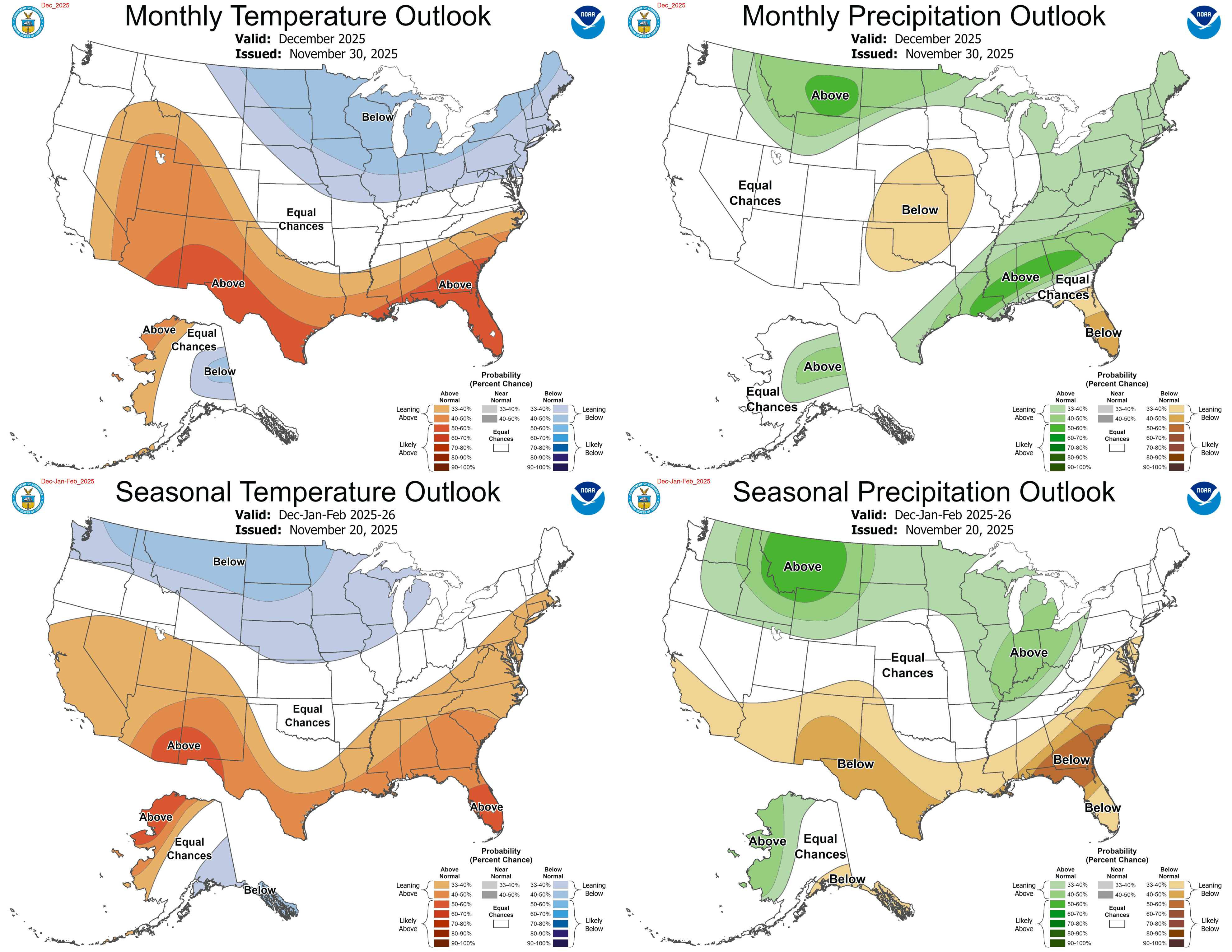Weather and Climate Summary and Forecast
December 2025 Report
December 7, 2025
Summary:
-
The western US experienced a warmer than average* November, with the Basin and Rockies seeing the warmest conditions during the month.
-
The forecast for precipitation in November, however, was a bust and clearly unforeseen in the seasonal outlooks. The result was a much wetter than average November in California and drier than average conditions in the PNW.
-
Drought conditions have remained in the PNW and Southwest but are much improved in California. The problem is that much of the precipitation so far has been from rain, leaving an early season ‘snow drought’ across nearly all mountain basins in the western US. Concerned, yes, yet there is still time to make up snow deficits.
-
A strong ridge centered just northwest of California will bring mostly mild and dry conditions to the state, with the exception of prolonged tule fog in the central valley. The northern edge of the ridge is right at the OR-CA border, where strong moisture plumes will be able to move west to east and likely bring significant rainfall to the PNW.
-
After a relatively warm forecast for the first 20 days of December, the last 10 days are forecast to experience cool to average or below average temperatures. The forecast also points to a wet north and dry south; however, conditions in November did not hold to this forecast, and I am skeptical about December as well.
-
La Niña conditions are in place in the Tropical Pacific. This La Niña continues to be seen as a likely weak to mild, short duration event. But a strong negative phase of the PDO and a weak La Niña continue to tilt the odds to a cooler and wetter winter from northern California into the PNW, and cool to near average and dry into southern California and the southwest.
*Note that unless stated otherwise, all references to normal or averages in this report are to the 1991-2020 climate normal for each weather/climate parameter. See this website for more information on climate normals.
Past Month and Year to Date:
Forecasted warmer than average temperatures for November 2025 held true, with the entire western US much warmer than normal (Figure 1). The month was the warmest in the Basin and Rockies, where temperatures were 6-10°F above average for the month. The conditions were largely driven by ridging in the west for most of the month, which also created the strong trough in the east, bringing much colder than average temperatures (3-6°F below) to the Great Lakes, mid-Atlantic, and New England (not shown). However, the forecast for a wetter PNW and drier southern portions of the western US did not hold and was actually the opposite of what was forecast (Figure 1). Early in the month, a deep trough brought significant and record breaking rainfall to California and the southwest, ending the month with over 300% of average across the region. At the same time, the PNW experienced a very dry month with 5-70% of normal in most areas, although the inland PNW was closer to average for the month. Across the country, November 2025 saw wetter than average conditions across the southwest, Rockies, and central Plains, across portions of the northern Plains, while other areas were near average to slightly above average (not shown).

Figure 1 – Western US November 2025 temperature departure from normal (left) and percent of normal precipitation (right; images from Western Region Climate Center and High Plains Regional Climate Center).
As we head into the last month of 2025, temperatures are holding above average year-to-date for the western US (Figure 2). The region has averaged 0.5-4.5 degrees above normal, with coastal zones in California and some isolated mountain regions closer to average or slightly cooler than average. The rest of the continental US has experienced a warmer than average year, currently ranking as the seventh or eighth warmest year since 1985. The eastern seaboard has seen temperatures closer to average (0.5-2.0 degrees) while the Plains south to Texas have seen temperatures running 2-4 degrees warmer than average year-to-date (not shown).
Year-to-date precipitation amounts in the western US are largely remaining near average to above average, with values ranging from 70-200% (Figure 2). The areas that have seen the wettest conditions have been across much of California, portions of the southwest, and inland areas of Oregon and Washington, across to Idaho and Montana. The driest regions have been across much of the rest of the PNW, Utah, portions of the Four Corners, and the western slope of Colorado, which have experienced 50-90% of normal precipitation (Figure 2). The rest of the country has seen a mixed year-to-date, with the northern to southern Plains, the Ohio River valley, and the mid-South experiencing a moderately wetter than average year-to-date, while drier regions of the country are most evident in Florida, portions of the Great Lakes, and southern Texas (not shown).

Figure 2 – Western US year to date (January 1 through November 30, 2025) temperature departure from normal (left) and percent of normal precipitation (right; images from Western Region Climate Center and High Plains Regional Climate Center).
Drought Watch – Moderate to substantial precipitation amounts during November over the west (Figure 1) resulted in a lessening of drought in the region, while other areas of the country received enough precipitation to lower concerns in some regions (Figure 3). The overall drought pattern in the west continues to show the inland PNW, Northern Rockies, and southwest regions remaining moderately to significantly dry. For the continental US, the overall drought footprint depicted in Figure 3 declined slightly to 67% with the most extreme drought categories also dropping slightly to 16%. A wet November in the southern areas of the west brought the overall footprint down to just over 69% with the most extreme categories dropping the most to 22% of the west in more extreme drought conditions. November was relatively dry in the PNW, leaving Washington’s overall drought area at close to 99%, while the most extreme categories dropped nearly 30% to 34% today. Oregon was also mostly dry in November (Figure 1), increasing the state’s drought footprint from 54% to just over 74%; however, the extreme drought categories (severe, extreme, and exceptional) declined slightly to 6%. Montana saw a slight decline in its overall drought footprint to just below 65% of the state in some level of drought, with the extreme categories dropping to nearly 31% of the state. Idaho remained at close to 92% of the state now in some level of drought, but has seen the more extreme categories of drought drop to just below 24%. A wet November in most of California (Figure 1) continued to lower drought concerns in the state. Overall, the drought footprint dropped from 51% to close to 17%, while the more extreme drought categories are no longer found in the state (Figure 3, left panel).
The seasonal drought outlook continues to indicate the likelihood of improvement in drought or removal altogether in the PNW (Figure 3; right panel). California is forecast to be mostly drought-free, while the southwest remains one of the driest regions in the country. Of concern is the early season lack of snow in the mountains, with most basins currently having extremely low snowpacks and snow water equivalents. Dry conditions are also expected to continue or develop further across the Plains, portions of Texas, and Florida, while conditions will likely improve over much of the rest of the country.

Figure 3 – Current US Drought Monitor and Seasonal Drought Outlook.
ENSO Watch – The anticipated shift to La Niña conditions in the Tropical Pacific has occurred, although western US effects have been slow to develop or opposite of what would be expected. Currently, the Climate Prediction Center has the ENSO alert system in a La Niña advisory. SSTs in the central-eastern equatorial Pacific are mostly below average (Figure 4), indicating that the tropical Pacific is currently in a La Niña state, with models indicating a likely gradual cooling trend over the next few months. The evolution of other key oceanic and atmospheric variables is consistent with La Niña conditions. The Climate Prediction Center is forecasting this event to be slightly weaker and short-lived. The multi-model plume forecast places the probability of La Niña at 67% for November-January, dropping to 53% for December-February 2025/26. From January-March onward, conditions begin shifting toward ENSO-neutral, which becomes the dominant outlook further into 2026. Much of the seasonal forecast below and drought outlook above are still betting on La Niña bringing a cooler and wetter winter to the PNW, while drier and milder conditions are still forecast for California and the southwest. However, the first month of winter has been anything but La Niña normal!

Figure 4 – Global sea surface temperatures (°C) for the period ending December 1, 2025 (image from Tropicaltibits.com).
North Pacific Watch – The pattern in North Pacific SSTs has remained spatially consistent over the last few months (Figure 4), continuing the persistent negative or cool phase that it has been in since late 2019. The Gulf of Alaska continues to be slightly cooler than average, while near shore SSTs all along western North America remain warmer than average. Warm SSTs also continue over a large area in the central North Pacific. This type of pattern in North Pacific SSTs is largely in phase with the tropical Pacific, which is cooler than average and in a La Niña (see above). The combination of a cold PDO and weak La Niña winter has commonly brought cooler temperatures and higher precipitation amounts to the PNW and northern states, while California and southern states tend to be near normal to warmer than normal and drier than normal during the winter. However, this winter has not started off as historic relationships such as these would suggest (see the 90-day forecast below).
Forecast Periods
Next 5 Days: Persistent ridge continues over the eastern Pacific just NW of California, although it flattens out enough on its northern edge to allow significant west to east flow. The result is that the PNW will see the start of strong onshore flow and precipitation associated with atmospheric rivers. California and the southwest will remain under the ridge influence with continued tule fog in the central valley, while most everywhere else will be warm and mild.
6-10 Day (valid December 12-16): East Pacific/Western US ridge will continue for at least another 1-2 weeks, with the dominant feature for this forecast period being warmer than average over the entire western US. Due to the sinking air, the tule fog conditions will likely continue in the midst of the warmer than average conditions elsewhere. Precipitation events are still likely to ride over the north of the ridge, bringing above average precipitation to the PNW, while the rest of the west is forecast to remain dry. Cold and dry conditions over most of the eastern third of the country.
8-14 Day (valid December 14-20): The ridge is forecast to persist in this forecast period, with the majority of the western US likely to see above average temperatures, although some lingering tule fog is likely in the central valley of California will keep temperatures below average there. In terms of precipitation, systems are forecast to continue sliding over the northern edge of the ridge, bringing above average rainfall to the PNW and northern tier of states, while the vast majority of the southern regions from west to east are likely to see drier than average conditions.
30 Day (valid December 1-31): After a relatively warm forecast for the first 20 days of December, the last of the month is forecast to be cool to average or below average. This results in a December that is likely to be close to average except in the Basin and Southwest, where warmer than average temperatures are likely (Figure 5). The greatest probability of a warmer than average month is across the southern tier of states, while the Plains across the Great Lakes are forecast to experience a cooler than average month. The precipitation forecast for December indicates that the western US is largely expected to be somewhere near average with equal chances of above to below for most everywhere in the west. The earlier December precipitation patterns will likely produce a wetter than average month in the inland PNW across the northern tier of states. A wetter than average month is also forecast across the Great Lakes and from the mid-Gulf States up along the eastern seaboard into New England. Florida is forecast to see below average precipitation in the month of December (Figure 5).
90 Day (valid December-January-February): Even though the first month of winter has not followed the typical La Niña patterns (Figure 1), seasonal forecasting agencies are sticking with the conditions expected from a La Niña. These include a wetter and colder PNW across the northern tier of states and a warmer and drier southern tier of states (Figure 5). The area forecast to have the greatest probability of above average temperatures and below average precipitation during the winter includes the southwest, Texas, the southeast, and Florida. The 90-day precipitation forecast points to wetter than average conditions across the PNW, the northern Plains, and the Great Lakes while the southern states are forecast to see below average winter precipitation amounts (Figure 5). The signal for winter precipitation is mixed for portions of California with equal chances for below to above average precipitation.

Figure 5 – Temperature (left panel) and precipitation (right panel) outlooks for the month of December (top panel) and December, January, and February (bottom panel) (Climate Prediction Center, climate.gov).
